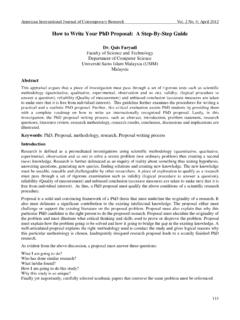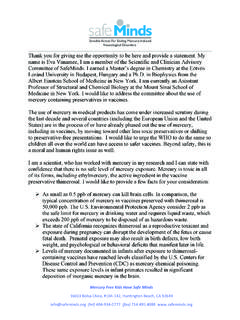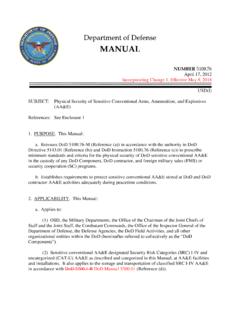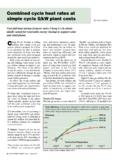Transcription of April 2012 - WHO
1 Hiv/aids ProgrammeUse of AntiretrovirAl DrUgs for treAting PregnAnt Women AnD Preventing Hiv infection in infAntsEXECUTivE sUMMaRYApril 2012 PRogRaMMaTiC UPdaTE1 EXECUTIVE SUMMARY Recent developments suggest that substantial clinical and programmatic advantages can come from adopting a single, universal regimen both to treat HIV-infected pregnant women and to prevent mother-to-child transmission of HIV. This streamlining should maximize PMTCT programme performance through better alignment and linkages with antiretroviral therapy (ART) programmes at every level of service delivery. One of WHO s two currently recommended PMTCT antiretroviral (ARV) programme options, Option B, takes this unified approach.
2 Now a new, third option (Option B+) proposes further evolution not only providing the same triple ARV drugs to all HIV-infected pregnant women beginning in the antenatal clinic setting but also continuing this therapy for all of these women for life. Important advantages of Option B+ include: further simplification of regimen and service delivery and harmonization with ART programmes, protection against mother-to-child transmission in future pregnancies, a continuing prevention benefit against sexual transmission to serodiscordant partners, and avoiding stopping and starting of ARV drugs. While these benefits need to be evaluated in programme settings, and systems and support requirements need careful consideration, this is an appropriate time for countries to start assessing their situation and experience to make optimal programmatic choices.
3 This programmatic update is meant to provide a current perspective for countries on the impor-tant changes and new considerations arising since publication of WHO s PMTCT ARV guide-lines, 2010 version, especially as a number of countries are now preparing to adopt Option B+. WHO has begun a comprehensive revision of all ARV guidelines, including guidance on ARVs for pregnant women, planned for release in early of mother-to-child transmission of HIV (PMTCT) is a dynamic and rapidly changing field. Current World Health Organization (WHO) PMTCT antiretroviral (ARV) guidelines on treating pregnant women and preventing infection in infants (1), issued in 2010, were a major step towards more effica-cious regimens.
4 The WHO guidelines emphasize the impor-tance of providing lifelong antiretroviral therapy (ART) to all HIV-infected pregnant women eligible for such treatment and recommend two short-term antiretroviral prophylaxis options (Option A and Option B) for women not eligible under current criteria, as determined by CD4 count, for treatment for their own health (Table 1). Recently, a third option, to provide life-long ART to all HIV-infected pregnant women, regardless of CD4 cell count, has emerged (Option B+), and a number of countries are already adopting or considering this approach. Although many low- and middle-income countries are still in early stages of implementing the 2010 guidance, new evidence and recent experience warrant a programmatic update to reassess preferences between Options A and B for prophylaxis in HIV-infected pregnant women who do not need treatment for their own health and to weigh the poten-tial advantages and considerations of the new Option B+ approach in a public health WHO guidance on ARV use in HIV-infected pregnant womenThe 2010 WHO PMTCT ARV guidelines are based on the need to distinguish between treatment and prophylaxis.
5 Consistent with the 2010 WHO adult ART guidelines (2), they recommend and prioritize starting all women with CD4 counts 350 cells/mm3 or WHO Stage 3 or 4 disease (approximately 40 50% of all HIV-infected pregnant women) on ART for life for their own health as well as for the prevention of infant HIV infection. For women with CD4 counts >350 cells/mm3, who are not eligible for treatment according to current criteria, the PMTCT ARV guidelines recommend starting ARV prophylaxis early in preg-nancy and, in breastfeeding settings, providing extended ARVs to either the mother or child during the postpartum risk two recommended prophylaxis options, A and B, are quite different programmatically but were judged to be equally effi-cacious, if implemented appropriately, in reducing the risk of infant infections for women with CD4 counts >350 cells/mm3.
6 Because of the difference in the prophylaxis options, it is sometimes not well understood that Options A and B include both treatment and prophylaxis components, as shown in Table 1. The overall effectiveness, both for the mother s health 2and for preventing new infant infections, of implementing either of the options depends on providing both ARV treat-ment to those with low CD4 counts and prophylaxis to those with higher CD4 counts. Countries were asked to weigh the benefits and uncertainties of the two approaches, particularly the operational issues, in order to determine the best approach for their national for this updateIn the short time since the 2010 PMTCT ARV guidelines were developed, the context and expectations for PMTCT programmes have changed considerably.
7 Major changes include: the ambitious goals for eliminating paediatric HIV infec-tion of the new Global Plan Towards the Elimination of New HIV Infections Among Children by 2015 and Keeping Their Mothers Alive (3), together with substantial progress in the global scale-up of PMTCT and ART coverage (4); new evidence to support ARV treatment as HIV preven-tion notably that provision of ART to HIV-infected indi-viduals with higher CD4 cell counts, who are not eligible for treatment, significantly reduces sexual transmission to a serodiscordant (uninfected) partner (5); this evidence has led to new WHO recommendations on couples counselling and treatment for serodiscordant couples regardless of CD4 count (6); increasing country experience with operational and programme implementation challenges with both Option A and Option B; the proposal by some countries to move to the new Option B+ approach of lifelong ART for PMTCT for all HIV-infected pregnant women, rather than stopping ARVs for women not eligible for treatment, as in both Option A and Option B (7).
8 The launch of the Treatment Initiative to simplify and optimize the use of ARVs and standardize the first-line treatment regimen (8,9); reassuring data on the safety of efavirenz in pregnancy (10); and the decreasing cost of ARV drugs (11,12). In addition, concerns have been raised that WHO s recommen-dation of two different options for PMTCT prophylaxis for HIV-infected women who do not require treatment for their own health might be confusing and should be reconsidered in light of newly recognized potential benefits, operational experiences and the programme requirements of the various 1. Three options for PMTCT programmesWoman receives:Infant receives:Treatment (for CD4 count 350 cells/mm3)Prophylaxis (for CD4 count >350 cells/mm3)Option AaTriple ARVs starting as soon as diagnosed, continued for lifeAntepartum: AZT starting as early as 14 weeks gestationIntrapartum: at onset of labour, sdNVP and first dose of AZT/3TC Postpartum: daily AZT/3TC through 7 days postpartumDaily NVP from birth through 1 week beyond complete cessation of breastfeeding.
9 Or, if not breastfeeding or if mother is on treatment, through age 4 6 weeks Option BaSame initial ARVs for bothb:Daily NVP or AZT from birth through age 4 6 weeks regardless of infant feeding methodTriple ARVs starting as soon as diagnosed, continued for lifeTriple ARVs starting as early as 14 weeks gestation and continued intrapartum and through childbirth if not breastfeeding or until 1 week after cessation of all breastfeedingOption B+Same for treatment and prophylaxisb:Daily NVP or AZT from birth through age 4 6 weeks regardless of infant feeding methodRegardless of CD4 count, triple ARVs starting as soon as diagnosed,c continued for lifeNote: Triple ARVs refers to the use of one of the recommended 3-drug fully suppressive treatment options.
10 A Recommended in WHO 2010 PMTCT guidelinesb True only for EFV-based first-line ART; NVP-based ART not recommended for prophylaxis (CD4 >350)c Formal recommendations for Option B+ have not been made, but presumably ART would start at programmatic update, while not presenting new guide-lines, reviews the currently recommended Options A and B, discusses the rationale for Option B+, and provides an update from WHO indicating and weighing preferences as much as possible among the range of options. This update summarizes key issues that need to be addressed in field settings and in national programmes. It also highlights evidence gaps that need to be addressed to build a base for future revision of findingsThis programmatic update indicates that Options B and specifically B+ are likely to prove preferable to Option A for operational, programmatic and strategic reasons.
















